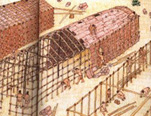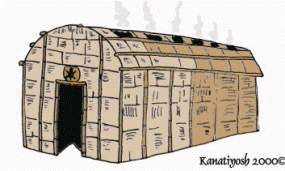
Indians of the East
The Indians who lived in the eastern part of the United States were hunters and farmers. They tracked animals silently in the thick forests, fished in the swift streams, and grew many crops. People in the East had plenty to eat.
During the winter, frost covers the branches of mountain trees. Winters were often cold and long in the northeastern part of the woodlands. Indians there had a way of life that was well suited to the cold winters and the mild summers.
The Indians built sturdy houses for protection against the cold. In many villages Indians lived in shelters called longhouses.

Dried corn usually hangs from the ceiling of the longhouse. They would crush dried corn kernels into flour for making cereal and bread. Smoke from fires could be seen coming from the top of the longhouse, where woman were cooking food in clay pots. The smoke would escape through openings in the roof. When there was heavy rain or snow, the Indians covered the openings with large pieces of bark. Then the inside of the longhouse would fill with eye-stinging smoke.

Many related families had a space for sleeping and a place for storing clothing, tools, weapons, and other supplies. Bearskins and deerskins were kept in the sleeping space. They made warm, coverings on cold winter nights.
The Indians made maple sugar from the sap of maple trees. They used this sugar to make their cornmeal sweet. The people who lived near the Great Lakes ate the wild rice that grew in the swampy fields. Indians everywhere knew how to make a delicious meal out of nuts, berries and other wild plants.
During the spring, the Indians spent most of their time working outdoors. The woman worked in the garden and grew the vegetables. To get rid of weeds they used a tool made from a tree branch and an animal bone. Corn, beans and squash were planted together in small mounds or hills. They harvested in the autumn.
Before harvesting the corn, many woodland Indian tribes held a celebration called the Green Corn Festival. Men and women danced and sang songs to give thanks for a good corn crop.
When the crops were reading for harvesting, the women gathered them from the fields. The Indians dried and stored most of the corn for later use.
The men and boys hunted and fished throughout the year. They traveled the waterways in canoes made of elm or birch bark. In the streams and lakes were many kinds of fish The men used nets, traps, and spears to catch them.
Using bows and arrows, the men and boys hunted in the woods for deer, bears, and other animals. They brought the animals to the village, where the women prepared them for use. They made bones into tools such as needles and scrapers. They used skins to make clothing, containers, and blankets. Some meat was cooked and eaten. The rest was dried in the sun or over low fires. Dried meat and other foods were stored to be eaten during the long winter months.
All of the Indians of the East knew how to use the good thins that nature gave them.
